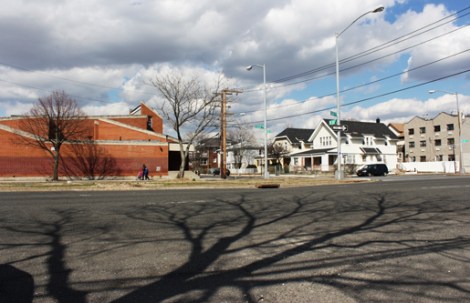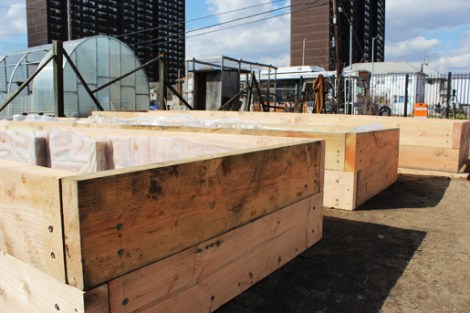Nestled along a residential stretch of Seagirt Boulevard in Far Rockaway, the Seagirt Boulevard Community Garden has been a green fixture in this Queens neighborhood for over two decades.
[protected-iframe id=”c99b8360fce430d01c29df6ee9719d56-5104299-30178935″ info=”http://dgjigvacl6ipj.cloudfront.net/media/swf/PBSPlayer.swf” width=”470″ height=”301″]
A photograph of the space from 2009 reveals row after row of neatly planted greens, herbs, and flowers — some held up toward the sun by wooden stakes and twine. An American flag stands tall alongside the garden’s center path, lined with stone grey bricks.
Over the years, the abundance at Seagirt has included kitchen staples like kale and potatoes, along with more unusual offerings of cat mint and bayberry. One volunteer plants a peanut crop.
Yet after Superstorm Sandy rolled through New York last fall — causing an estimated $19 billion in public and private losses in the city alone — little remained of the garden aside from its still-standing flagpole and wooden shade structure.
A now-faded line on the garden’s outlying fence serves as a reminder of the storm surge, which rose to over four feet at Seagirt.

New York Restoration ProjectLeft: The garden in full bloom in 2009. Right: Cleared out after Hurricane Sandy, January, 2013.
Members of New York Restoration Project were on the scene shortly after Sandy hit to assess the damage, but not before Sharon Keller, a resident of the Rockaways for the past 20 years who has been a volunteer “grower” at the garden since 2008.
“I was the first one on the scene to get over here and actually see the aftermath of Sandy,” she said. “Everything was just a mess … It was like a scene out of some kind of war zone. I didn’t have high hopes at all.”
Before Sandy struck, Keller said her patch was prolific, boasting rutabagas, collard greens, and tomatoes. Keller worked in raised boxes and planted her seeds alongside nasturtium and “big plants like callaloo.”
“It was glorious,” she said. “I was growing so many things. I was growing more than Little House on the Prairie!”

Elisabeth Ponsot / PBS Need to KnowSeagirt Boulevard in Far Rockaway.
Seagirt is cared for by a group of mostly elderly, local volunteers from the surrounding area in Far Rockaway. In a primarily African-American neighborhood — where about 35 percent of the population received some sort of governmental assistance in 2011 and few grocery options abound — the garden is a local source for organic produce.
Keller, who suffers from the autoimmune disease lupus and cannot work, said the access to fresh vegetables has been “invaluable,” considering her health concerns.
“It’s a godsend,” she said. “I am very concerned about what I consume, and I can grow fresh, organic heirloom vegetables in the middle of Queens, a couple of blocks away from my home.”
When the superstorm’s surge rushed through the space last October, the water pulled up Keller’s plot and rest of the garden with it.
“The [front] fence acted like a colander,” said Jason Sheets, NYRP’s regional director. “The water just pushed everything it could up against [the fence], and then with the force of the water, everything else went out into the street.”
Immediately, Sheets said, he knew the saltwater that had saturated the ground would pose the greatest threat to future crops. When soil testing confirmed his fears, his team began to construct raised boxes and haul in fresh soil.

Elisabeth Ponsot / PBS Need to KnowRaised bed construction at Seagirt Community Garden.
With financial assistance from TD Bank, Sheets’ team will build 21 new planting beds, reconstruct a garden path, repair fencing, and replace patio furniture.
Sheets said he hopes the garden’s new design will encourage a wider range of participants. He also wants to plan more community events, starting with a screening of Finding Nemo slated for this June.
Keller, for one, is looking forward to a new look and feel for the garden she’s come to love over the past five years.
“After Sandy, it was very depressing … We knew that Sandy would come and we knew it would have an aftermath, but never this severe,” she said. “People banded together and now you see signs of reconstruction and hopes of reconstruction — but we’re still reeling from Sandy. You see a lot of people who haven’t been able to come back. So even people who stop at the bus stop and walk past the garden, when they see it they have a desire to come in.”
“It’s like a respite, in a sea of things that are still in pretty bad shape.”
 This story was produced by PBS: Need to Know as part of the Climate Desk collaboration.
This story was produced by PBS: Need to Know as part of the Climate Desk collaboration.


